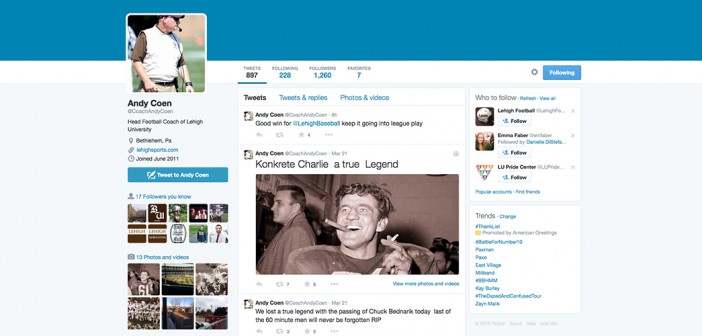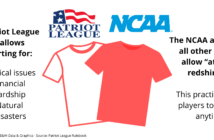When Larry Bird and Magic Johnson were destroying their competition en route to a head-on collision in the NCAA tournament 36 years ago this month, they didn’t have cell phones to tweet out their emotions after a game. They didn’t have coaches recruiting them through direct messages on Twitter or Facebook, or Hudl to post their highlight tapes to share with the world.
For many athletes and coaches today, however, the use of social media has increased when it comes to recruitment.
With coaches across the country searching for any advantage in recruiting the best student athletes to eventually lead their team to championships, social media is utilized to reel the players in, in an environment that the student athletes are comfortable with.
At Lehigh, this recruitment process is no different.
“I think you have to engage in social media now,” said Andy Coen, coach of Lehigh’s football team. “Pretty much every staff member has a Twitter account so they can communicate with the guys that they are recruiting.”
Coaches in all sports utilize Hudl.com, a website where high school athletes can upload their highlight videos for recruiters to see.
“Hudl is great,” Coen said. “Let’s say I’m in my office and one of my coaches is in Florida. He can see a kid in practice, and say, ‘Hey coach, check out Steve Jones on Hudl,’ and I can look at his highlight tape. It’s a very helpful tool.”
At Lehigh, the football coaches are not allowed to text message the players they are recruiting. This rule was created to ensure that student athletes were not receiving too many text messages while in class and to avoid forcing students to pay for a texting plan. Since many people now have unlimited texting plans, however, the rule may be retracted, Coen said.
For now, the coaches use direct messaging on Twitter as a substitute to communicate with their recruits.
“When I offer somebody, I ask him to follow me, and I follow him,” Coen said. “Then, we can stay in touch, not only for communication, but also to see what tweets that he sends out.”
For Coen and the rest of Lehigh’s coaches, this tool of checking what a student athlete tweets is very helpful. Before the players come to campus and meet with the coaches, a student’s tweets can give a sneak peak into the type of person the athlete might be.
For Lehigh women’s soccer coach Eric Lambinus, however, looking at the players’ Twitter and Facebook accounts can be very dangerous.
“Even with their friends, it isn’t an indication of how these people are,” Lambinus said. “This is just one snapshot of everything that is going on. So they have to be very careful about that. It does affect student athletes when they see all that their friends are posting, but what you have to understand is that isn’t their entire life. There are a lot of things going on.”
For some student athletes, Twitter and other social media sites can have a variety of negative effects.
For example, when current NFL wide receiver and Lehigh graduate standout Ryan Spadola sent out an offensive tweet in 2011, he hurt Lehigh’s chances of making a run in that year’s playoffs.
Spadola retweeted a message tweeted by a friend of his that contained the “n-word.” Although the tweet was meant as motivation for Spadola, the tweet contained offensive language.
From this experience, the Lehigh sports community learned that student athletes can also suffer consequences from posting insensitive or inappropriate messages on Twitter. As a result of the tweet, Spadola was suspended for Lehigh’s quarterfinal game against North Dakota State University that year.
“We talk a lot about how (the athletes) represent more than just themselves,” Lambinus said. “We want to make sure that their public image is the right one out there. We tell them, ‘Don’t put out something out there that your grandparents or parents wouldn’t want to see.’”
Student athletes represent sports, their team and Lehigh. When one student is irresponsible, it affects the whole team. One player who is arguably in the spotlight more than any other student athlete is the quarterback of the football team.
“We have to monitor each other’s accounts,” sophomore quarterback Nick Shafnisky said. “The seniors and I, we have to check up on each other and the team. The main thing is that it might not be us who is doing the tweeting, but other people tweeting to us. Coach stresses that a lot.”






Comment policy
Comments posted to The Brown and White website are reviewed by a moderator before being approved. Incendiary speech or harassing language, including comments targeted at individuals, may be deemed unacceptable and not published. Spam and other soliciting will also be declined.
The Brown and White also reserves the right to not publish entirely anonymous comments.